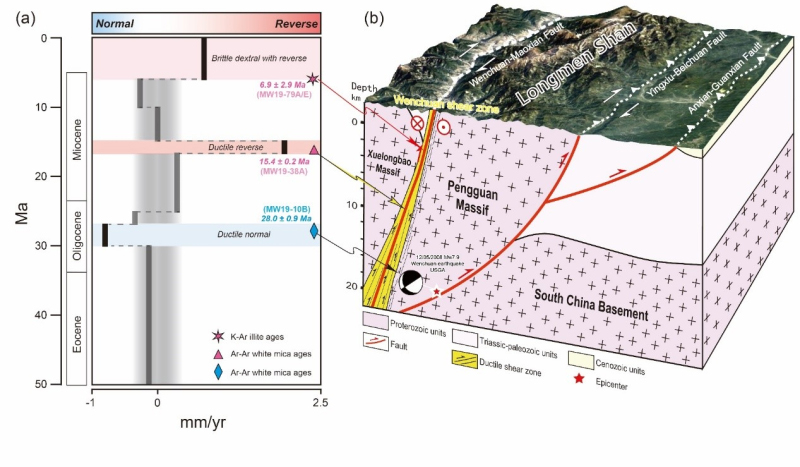Publication of the LGL-TPE in the journal Tectonophysics on April 28, 2023. Communication of the CNRS-INSU on June 12, 2023.
A research team has recently published a study on the mechanism of crustal flow in the journal Tectonophysics. They have reconstructed the evolution of the Wenchuan fault, located to the east of Tibet, over the last thirty million years. Their work calls into question the crustal flow mechanism in this emblematic zone.
Abstract
The Longmen Shan, eastern and steepest margin of the Tibetan plateau, is often seen as the archetype example of an orogenic system built by crustal channel flow extrusion since the Miocene. This model is controversial as other studies propose an accretionary prism mechanism. A key difference between these models resides in the kinematics proposed for the Wenchuan - Maoxian (WM) fault zone, a major tectonic structure of the Longmen Shan. We constrain the Cenozoic kinematics of the WM fault zone by combining structural observations, fault gouge K/Ar dating and 40Ar/39Ar dating of syn-kinematic white mica. Normal / right lateral ductile deformation occurred at 28.0 ± 0.9 Ma while top-to-the-east reverse deformation at 15.4 ± 0.2 Ma. K/Ar ages of authigenic illite from two fault gouges show that brittle right-lateral / reverse deformation was active at 6.9 ± 2.9 Ma. These ages are consistent with the relative vertical motions across the fault zone deduced from thermochronology. Three deformation phases can be identified: right-lateral / normal in the Middle Oligocene (∼30–25 Ma), reverse in the middle Miocene (25–15 Ma), and right-lateral / reverse since the upper Miocene (since ∼6 Ma). The WM fault zone never experienced pure normal motion, and only shortening since the Oligocene, in contrast to predictions of lower crustal channel-flow extrusion models. These results are in favor of a crustal accretionary prism model for the Cenozoic building of the eastern Tibetan plateau.

Credits - Chenglong Ge, Philippe Hervé Leloup et al.
Reference: Cenozoic kinematics of the Wenchuan-Maoxian fault implies crustal stacking rather than channel flow extrusion at the eastern margin of Tibetan plateau (Longmen Shan). Chenglong Ge, Philippe Hervé Leloup, Yong Zheng, Stéphane Scaillet, Laura Airaghi, Florian Duval, Jinjiang Zhang, Haibing Li. Tectonophysics, April 28, 2023.
DOI: 10.1016/j.tecto.2023.229816





